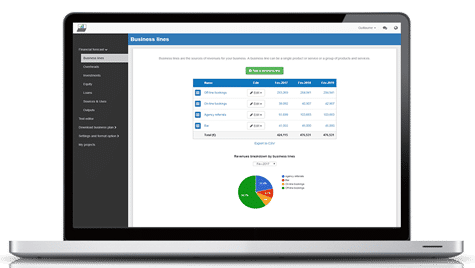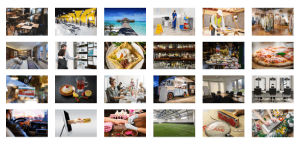How to create a financial forecast for a panini shop?
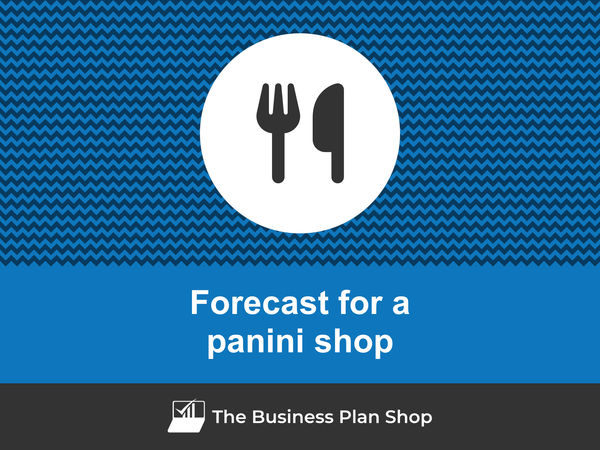
If you are serious about keeping visibility on your future cash flows, then you need to build and maintain a financial forecast for your panini shop.
Putting together a panini shop financial forecast may sound complex, but don’t worry, with the right tool, it’s easier than it looks, and The Business Plan Shop is here to guide you.
In this practical guide, we'll cover everything you need to know about building financial projections for your panini shop.
We will start by looking at why they are key, what information is needed, what a forecast looks like once completed, and what solutions you can use to create yours.
Let's dive in!
Why create and maintain a financial forecast for a panini shop?
The financial projections for your panini shop act as a financial blueprint to guide its growth with confidence and ensure its long-term financial viability.
To create them, you will need to look at your business in detail - from sales to operating costs and investments - to assess how much profit it can generate in the years to come and what will be the associated cash flows.
During challenging market conditions, maintaining an up-to-date financial forecast enables early detection of potential financial shortfalls, allowing for timely adjustments or securing financing before facing a cash crisis.
Your panini shop's financial forecast will also prove invaluable when seeking financing. Banks and investors will undoubtedly request a thorough examination of your financial figures, making precision and presentation essential.
Need a solid financial forecast?
The Business Plan Shop does the maths for you. Simply enter your revenues, costs and investments. Click save and our online tool builds a three-way forecast for you instantly.
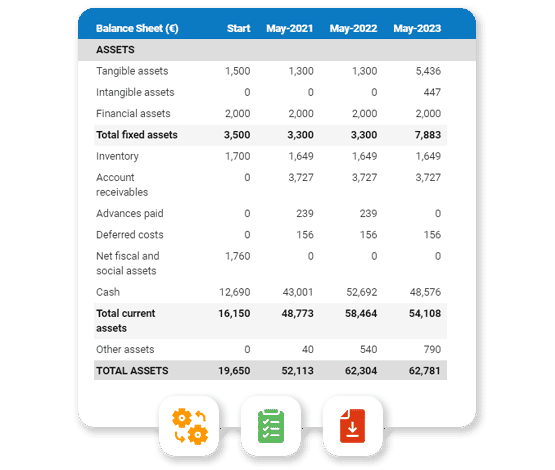
What information is used as input to build a panini shop financial forecast?
A panini shop's financial forecast needs to be built on the right foundation: your assumptions.
The data required to create your assumptions will depend on whether you are a new or existing panini shop.
If you are creating (or updating) the forecast of an existing panini shop, then your main inputs will be historical accounting data and operating metrics, and your team’s view on what to expect for the next three to five years.
If you are building financial projections for a new panini shop startup, you will need to rely on market research to form your go-to-market strategy and derive your sales forecast.
For a new venture, you will also need an itemised list of resources needed for the panini shop to operate, along with a list of equipment required to launch the venture (more on that below).
Now that you understand what is needed, let’s have a look at what elements will make up your panini shop's financial forecast.
The sales forecast for a panini shop
The sales forecast, also called topline projection, is normally where you will start when building your panini shop financial forecast.
Creating a coherent sales projection boils down to estimating two key drivers:
- The average price
- The number of monthly transactions
To do this, you will need to rely on historical data (for an existing business), market research data (for both new and existing panini shops), and consider the elements below:
- Seasonal Changes: As a panini shop owner, you know that the demand for paninis can vary depending on the season. During the warmer months, customers may prefer lighter, fresher options, while during the colder months, they may seek out heartier, warmer paninis. Therefore, it is important to take into account the seasonal changes when creating your sales forecast.
- Changing Consumer Preferences: With the rise of health-conscious consumers, there has been a shift toward healthier eating habits. This may result in customers seeking out healthier panini options with more vegetables and lean proteins. As a panini shop owner, it is important to stay updated on current food and diet trends to ensure you are meeting the demands of your customers.
- Competition: In a competitive market, it is essential to be aware of your competition and their pricing strategies. If a new panini shop opens up in your area, they may offer lower prices to attract customers. This may result in a decrease in your average price or number of monthly transactions. Keeping an eye on your competition can help you adjust your prices and stay competitive.
- Economic Factors: Economic factors such as inflation, unemployment rates, and consumer spending can greatly affect your business. During times of economic downturn, customers may limit their spending, resulting in a decrease in your average price or number of monthly transactions. It is important to consider the current economic climate when creating your sales forecast.
- Local Events: Your panini shop may be affected by local events such as festivals, concerts, or sports games. These events can bring in a large number of potential customers, resulting in an increase in your average price or number of monthly transactions. However, they can also cause road closures or limited parking, making it difficult for customers to reach your shop. Considering the timing and impact of local events can help you plan and adjust your sales forecast accordingly.
After the sales forecast comes the operating expenses budget, which we will now look into in more detail.
Need inspiration for your business plan?
The Business Plan Shop has dozens of business plan templates that you can use to get a clear idea of what a complete business plan looks like.
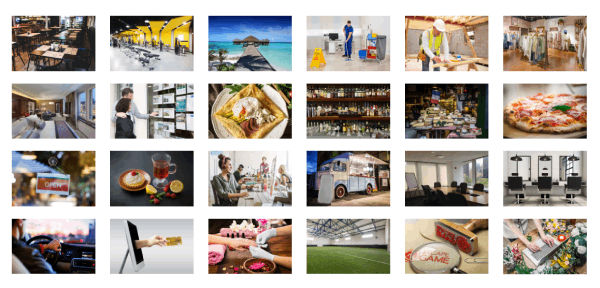
The operating expenses for a panini shop
The next step is to estimate the costs you’ll have to incur to operate your panini shop.
These will vary based on where your business is located, and its overall size (level of sales, personnel, etc.).
But your panini shop's operating expenses should normally include the following items:
- Staff Costs: Salaries, wages, and benefits for employees, including chefs, cashiers, and cleaning staff.
- Rent: Monthly rental fees for the shop space.
- Utilities: Monthly costs for electricity, water, and gas for the shop.
- Ingredients: Costs for purchasing bread, meats, cheeses, and other ingredients used to make the paninis.
- Packaging: Expenses for purchasing packaging materials, such as takeout containers and bags.
- Marketing: Costs for advertising and promoting the panini shop, including printing flyers and social media marketing.
- Accountancy Fees: Fees for hiring an accountant to manage your financial records and taxes.
- Insurance Costs: Monthly premiums for business insurance to protect against liability and property damage.
- Software Licences: Fees for using software programs, such as point-of-sale systems and accounting software.
- Banking Fees: Charges for maintaining a business bank account and processing credit and debit card transactions.
- Cleaning Supplies: Expenses for purchasing cleaning supplies, such as disinfectants and paper towels.
- Maintenance: Costs for repairing and maintaining kitchen equipment, furniture, and fixtures.
- Professional Services: Fees for hiring outside services, such as legal advice or consulting services.
- Training and Development: Expenses for employee training and development programs to improve skills and knowledge.
- Taxes: Monthly or quarterly payments for business taxes, such as sales tax and payroll taxes.
This list is not exhaustive by any means, and will need to be tailored to your panini shop's specific circumstances.
What investments are needed to start or grow a panini shop?
Your panini shop financial forecast will also need to include the capital expenditures (aka investments in plain English) and initial working capital items required for the creation or development of your business.
For a panini shop, these could include:
- Your panini shop location. This includes the cost of purchasing or renting a space, as well as any renovations or improvements needed to make it suitable for your business.
- Equipment and appliances. This includes items such as panini presses, refrigerators, and ovens. These are necessary for creating and storing your paninis, and can be a major expense for your business.
- Furniture and decor. This includes tables, chairs, and other furnishings for your shop, as well as any decorations or branding materials to create a welcoming atmosphere for your customers.
- Point-of-sale (POS) system. This is a necessary investment for tracking sales, inventory, and managing transactions. It can also include costs for software, hardware, and training.
- Initial inventory and supplies. This includes ingredients for your paninis, as well as any packaging materials, cleaning supplies, and other items needed to run your business on a daily basis.
Again, this list will need to be adjusted according to the size and ambitions of your panini shop.
Need a convincing business plan?
The Business Plan Shop makes it easy to create a financial forecast to assess the potential profitability of your projects, and write a business plan that’ll wow investors.
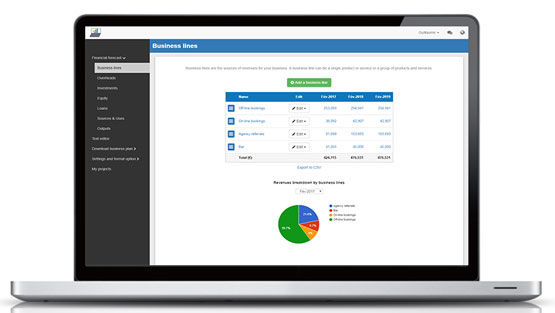
The financing plan of your panini shop
The next step in the creation of your financial forecast for your panini shop is to think about how you might finance your business.
You will have to assess how much capital will come from shareholders (equity) and how much can be secured through banks.
Bank loans will have to be modelled so that you can separate the interest expenses from the repayments of principal, and include all this data in your forecast.
Issuing share capital and obtaining a bank loan are two of the most common ways that entrepreneurs finance their businesses.
What tables compose the financial plan for a panini shop?
Now let's have a look at the main output tables of your panini shop's financial forecast.
The forecasted profit & loss statement
The profit & loss forecast gives you a clear picture of your business’ expected growth over the first three to five years, and whether it’s likely to be profitable or not.

A healthy panini shop's P&L statement should show:
- Sales growing at (minimum) or above (better) inflation
- Stable (minimum) or expanding (better) profit margins
- A healthy level of net profitability
This will of course depend on the stage of your business: numbers for an established panini shop will look different than for a startup.
The projected balance sheet
Your panini shop's forecasted balance sheet enables you to assess your financial structure and working capital requirements.
It is composed of three types of elements: assets, liabilities and equity:
- Assets: represent what the business owns and uses to produce cash flows. It includes resources such as cash, equipment, and accounts receivable (money owed by clients).
- Liabilities: represent funds advanced to the business by lenders and other creditors. It includes items such as accounts payable (money owed to suppliers), taxes due and loans.
- Equity: is the combination of what has been invested by the business owners and the cumulative profits and losses generated by the business to date (which are called retained earnings). Equity is a proxy for the value of the owner's stake in the business.

The cash flow projection
The cash flow forecast of your panini shop will show how much cash the business is expected to generate or consume over the next three to five years.

There are multiple ways of presenting a cash flow forecast but from experience, it is better to organise it by nature in order to clearly show these elements:
- Operating cash flow: how much cash is generated by the panini shop's operations
- Investing cash flow: what is the business investing to expand or maintain its equipment
- Financing cash flow: is the business raising additional funds or repaying financiers (debt repayment, dividends)
Your cash flow forecast is the most important element of your overall financial projection and that’s where you should focus your attention to ensure that your panini shop is adequately funded.
Note: if you are preparing a financial forecast in order to try to secure funding, you will need to include both a yearly and monthly cash flow forecast in your panini shop's financial plan.
Need a solid financial forecast?
The Business Plan Shop does the maths for you. Simply enter your revenues, costs and investments. Click save and our online tool builds a three-way forecast for you instantly.

Which tool should you use to create your panini shop's financial forecast?
Using the right tool or solution will make the creation of your panini shop's financial forecast much easier than it sounds. Let’s explore the main options.
Using online financial projection software to build your panini shop's forecast
The modern and easiest way to build a forecast is to use professional financial projection software such as the one we offer at The Business Plan Shop.
There are several advantages to using specialised software:
- You can easily create your financial forecast by letting the software take care of the financial calculations for you without errors
- You have access to complete financial forecast templates
- You get a complete financial forecast ready to be sent to your bank or investors
- You can easily track your actual financial performance against your financial forecast, and recalibrate your forecast as the year goes by
- You can create scenarios to stress test your forecast's main assumptions
- You can easily update your forecast as time goes by to maintain visibility on future cash flows
- You have a friendly support team on standby to assist you when you are stuck
- It’s cost-efficient and much cheaper than using an accountant or consultant (see below)
If you are interested in this type of solution, you can try our forecasting software for free by signing up here.
Hiring a financial consultant or chartered accountant
Hiring a consultant or chartered accountant is also an efficient way to get a professional panini shop financial projection.
As you can imagine, this solution is much more expensive than using software. From experience, the creation of a simple financial forecast over three years (including a balance sheet, income statement, and cash flow statement) is likely to start around £700 or $1,000 excluding taxes.
The indicative estimate above, is for a small business, and a forecast done as a one-off. Using a financial consultant or accountant to track your actuals vs. forecast and to keep your financial forecast up to date on a monthly or quarterly basis will naturally cost a lot more.
If you choose this solution, make sure your service provider has first-hand experience in your industry, so that they may challenge your assumptions and offer insights (as opposed to just taking your figures at face value to create the forecast’s financial statements).
Why not use a spreadsheet such as Excel or Google Sheets to build your panini shop's financial forecast?
Creating an accurate and error-free panini shop financial forecast with a spreadsheet is very technical and requires a deep knowledge of accounting and an understanding of financial modelling.
Very few business owners are financially savvy enough to be able to build a forecast themselves on Excel without making mistakes.
Lenders and investors know this, which is why forecasts created on Excel by the business owner are often frowned upon.
Having numbers one can trust is key when it comes to financial forecasting and to that end using software is much safer.
Using financial forecasting software is also faster than using a spreadsheet, and, with the rise of artificial intelligence, software is also becoming smarter at helping us analyse the numbers to make smarter decisions.
Finally, like everything with spreadsheets, tracking actuals vs. forecasts and keeping your projections up to date as the year progresses is manual, tedious, and error-prone. Whereas financial projection software like The Business Plan Shop is built for this.
Need a convincing business plan?
The Business Plan Shop makes it easy to create a financial forecast to assess the potential profitability of your projects, and write a business plan that’ll wow investors.

Use our financial projection templates for inspiration
The Business Plan Shop has dozens of financial forecasting templates available.
Our examples contain both the financial forecast, and a written business plan which presents, in detail, the company, the team, the strategy, and the medium-term objectives.
Whether you are just starting out or already have your own panini shop, looking at our template is always a good way to get ideas on how to model financial items and what to write when creating a business plan to secure funding.
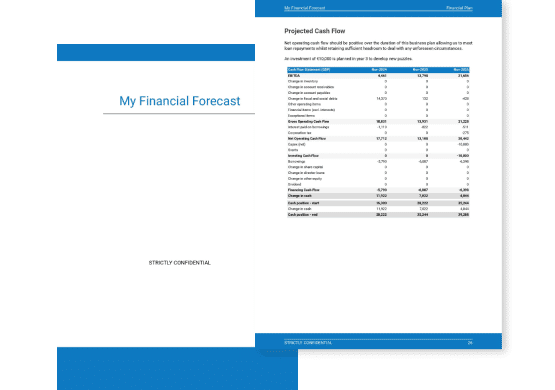
Takeaways
- A financial forecast shows expected growth, profitability, and cash generation metrics for your panini shop.
- Tracking actuals vs. forecast and having an up-to-date financial forecast is key to maintaining visibility on your future cash flows.
- Using financial forecasting software is the modern way of creating and maintaining financial projections.
We hope that this guide helped you gain a clearer perspective on the steps needed to create the financial forecast for a panini shop. Don't hesitate to contact us if you have any questions!
Need inspiration for your business plan?
The Business Plan Shop has dozens of business plan templates that you can use to get a clear idea of what a complete business plan looks like.

Also on The Business Plan Shop
Know someone who runs a panini shop? Share our business guide with them!

